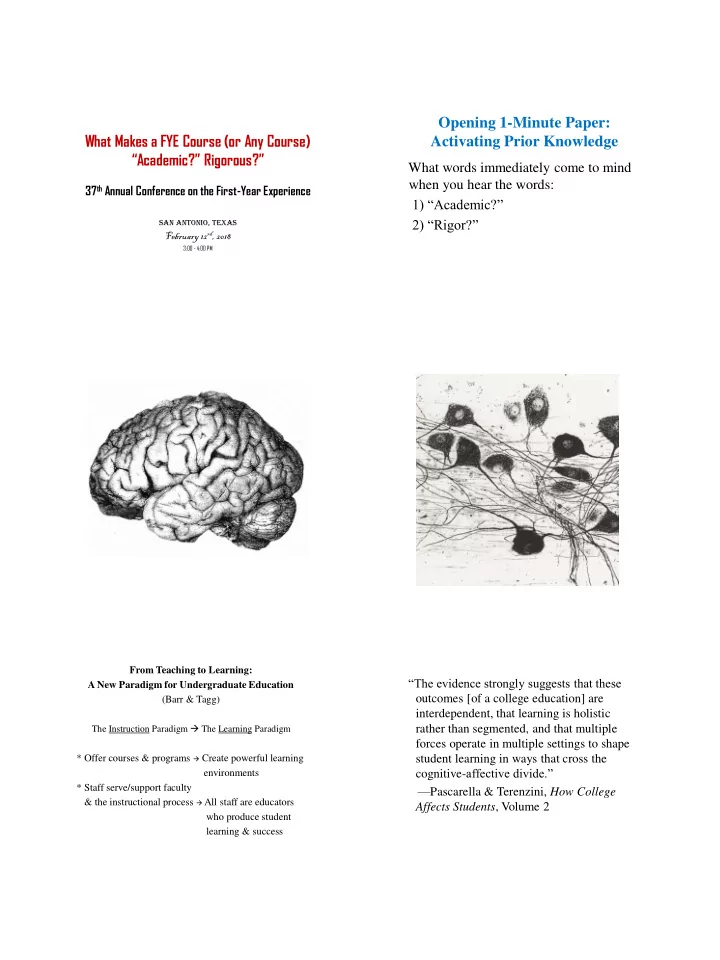

Opening 1-Minute Paper: What Makes a FYE Course (or Any Course) Activating Prior Knowledge “Academic?” Rigorous?” What words immediately come to mind 37 th Annual Conference on the First-Year Experience when you hear the words: 1) “Academic?” 2) “Rigor?” San Antonio, Texas February 12 rd , 2018 3:00 - 4:00 PM From Teaching to Learning: “The evidence strongly suggests that these A New Paradigm for Undergraduate Education outcomes [of a college education] are (Barr & Tagg) interdependent, that learning is holistic The Instruction Paradigm The Learning Paradigm rather than segmented, and that multiple forces operate in multiple settings to shape * Offer courses & programs Create powerful learning student learning in ways that cross the cognitive- affective divide.” environments * Staff serve/support faculty — Pascarella & Terenzini, How College & the instructional process All staff are educators Affects Students , Volume 2 who produce student learning & success
Creating an Effective Learning Sequence “Academic learning and personal development are intertwined reciprocal 1. Activate : before the presentation —as a “warm up” to processes that could just be called unearth students’ pre -existing ideas about the topic. learning, and indeed, learning is inherently developmental and 2. Punctuate : during the presentation — as a way to personal.” “break up” long periods of information reception with opportunities for reflection. — Komives & Schoper, in Learning Reconsidered 2: A Practical Guide to Implementing a Campus- Wide Focus on the Student Experience
Intermediate 1-Minute Paper: Intercepting Attention Loss How did the thoughts that came to your mind about the word “academic” at the start of this session compare to the thoughts just shared by me? In what way(s) are they similar? Different?
“I write to understand as much as to be understood.” — Elie Wiesel, Nobel prize winner and Holocaust survivor “Compulsions to cover so much material in class “Dysfunctional illusion of rigor: If we cover more content, the students will learn more content. are usually counterproductive, but they are Studies show that learning, student retention, and equity can be strongly increased by adopting active learning.” especially destructive in freshman courses. They reinforce passive listening, verbatim note-taking, “Dysfunctional illusion of rigor: Traditional methods of and superficial information-processing . . . We instruction offer effective ways of teaching content to undergraduates. need to give up our apparent belief that students In introductory physics, students classes taught with cannot learn it unless we say it.” traditional lectures usually learn about 23 percent of what they collectively missed on the pretest. Alternative methods — Erickson & Strommer, Teaching College teach on average twice as much as traditional lectures.” Freshmen — Craig E. Nelson, Professor Emeritus, Biology, Indiana University, Dysfunctional illusions of rigor: Lessons from the Scholarship of Teaching & Learning
One-Minute Paper Questions for Stimulating & Assessing Higher-Order Thinking Skills • What do you think were the central or most important ideas covered or points made in today’s ___? (Analysis) • What could you take away from today’s ____ and put to use in your life? (Application) • Was there anything you learned in today’s ____ that could be connected to, or integrated with something else you’ve learned? ( Synthesis) • What would you say was the major strength and weakness associated with today’s ___? ( Evaluation) “ Conceptually, we an separate intelligence, feeling, emotion, and action; but none of them functions independent of the others. Just as development of the whole person depends heavily upon exercise of cognitive functions, the cognitive normally develops in pace with the rest of the personality. In spite of this interdependence, educators are widely charmed by the idea of a disembodied intellect whole sole function is the intake, strorage , and reproduction of data.” — Nevitt Sanford (1967), Where Colleges Fail This ends my oral assault. Thanks for your attention.
Closing 1-Minute Paper: Creating an Effective Learning Sequence Intercepting Attention Loss 1. Activate : before the presentation —as a “warm up” to 1.What idea discussed in this session did you unearth students’ pre -existing ideas about the topic. think was: 2. Punctuate : during the presentation — as a way to a) Most important or significant? (Why?) “break up” long periods of information reception with b) Most useful? (How can you put it to use?) opportunities for reflection. 2. Are there unanswered questions that still 3. Consolidate : after the presentation —as a “wrap up” remain in your mind about today’s topic? to integrate ideas presented and create closure. Please remember to submit your Questions? Comments? evaluation on Guidebook! (Please!) https://guidebook.com/g/fye18/ #FYE18
Recommend
More recommend